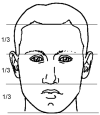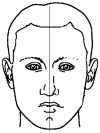Are the Reasons Why Patients Are Referred for an Orthodontic Visit Correct?
- PMID: 34068382
- PMCID: PMC8153563
- DOI: 10.3390/ijerph18105201
Are the Reasons Why Patients Are Referred for an Orthodontic Visit Correct?
Abstract
Who does refer patients for an orthodontic consultation? Which are the main reasons for the referral? Does the visit of the orthodontic specialist confirm these reasons or reveal undiagnosed problems? Is there the risk that only evident dental problems are addressed, while craniofacial malformations remain underdiagnosed? This cross-sectional epidemiologic study aims to answer these questions, analysing the clinical data collected during the orthodontic visits of 500 Caucasian young patients referred to a public health structure of northern Italy. All patients were visited by the same expert specialist in orthodontics. Clinical data were collected, analysing both dental and skeletal features. The reasons for the referral of the visit were analysed and compared with the specialistic diagnoses. In our sample, dentists, relatives/friends and paediatricians were the major source of the referrals, followed by family doctors and other facial specialists. In most cases, the reasons for the referral were dental irregularities, but approximately 80% of dental irregularities were associated with undiagnosed facial dysmorphism. Skeletal facial anomalies need an early diagnosis to prevent the development of severe facial malformations that would require invasive and expensive treatments. These findings reveal poor diagnostic skills regarding skeletal anomalies in dentists and paediatricians and the need for better specific training.
Keywords: community dentistry; delayed diagnoses; facial deformities; orthodontic diagnosis.
Conflict of interest statement
The authors declare no conflict of interest.
Figures







Similar articles
-
Dental screening and referral of young children by pediatric primary care providers.Pediatrics. 2004 Nov;114(5):e642-52. doi: 10.1542/peds.2004-1269. Pediatrics. 2004. PMID: 15520094
-
Orthodontic referrals: why do GDPs get it wrong?Br Dent J. 2016 Nov 4;221(9):583-587. doi: 10.1038/sj.bdj.2016.826. Br Dent J. 2016. PMID: 27811869
-
A comparison of consecutive orthodontic referrals seen by a consultant unit and specialist orthodontic practitioners.Br J Orthod. 1995 Nov;22(4):347-52. doi: 10.1179/bjo.22.4.347. Br J Orthod. 1995. PMID: 8580101
-
[Orthodontic treatment in children and adults].Rev Med Brux. 2001 Sep;22(4):A299-303. Rev Med Brux. 2001. PMID: 11680192 Review. French.
-
Orthodontic referrals via TeleDent Southwest.Dent Clin North Am. 2002 Jul;46(3):507-20. doi: 10.1016/s0011-8532(02)00010-1. Dent Clin North Am. 2002. PMID: 12222094 Review.
Cited by
-
Comparison of deep learning models to detect crossbites on 2D intraoral photographs.Head Face Med. 2024 Sep 2;20(1):45. doi: 10.1186/s13005-024-00448-8. Head Face Med. 2024. PMID: 39223562 Free PMC article.
-
A narrative review on obstructive sleep apnoea syndrome in paediatric population.Front Neurol. 2024 Jul 5;15:1393272. doi: 10.3389/fneur.2024.1393272. eCollection 2024. Front Neurol. 2024. PMID: 39036631 Free PMC article. Review.
References
-
- Proffit W.R., White R.P. Surgical-Orthodontic Treatment. Mosby Year Book; St. Louis, MO, USA: 1990.
-
- McKiernan E.X., McKiernan F., Jones M.L. Psychological profiles and motives of adults seeking orthodontic treatment. Int. J. Adult Orthod. Orthognath. Surg. 1992;7:187–198. - PubMed
-
- Sergl H.G., Zentner A. Study of psychosocial aspects of adult orthodontic treatment. Int. J. Adult Orthod. Orthognath. Surg. 1997;12:17–22. - PubMed
-
- Kerosuo H. Occlusion in the primary and early mixed dentitions in a group of Tanzanian and Finnish children. ASDC J. Dent. Child. 1990;57:293–298. - PubMed

